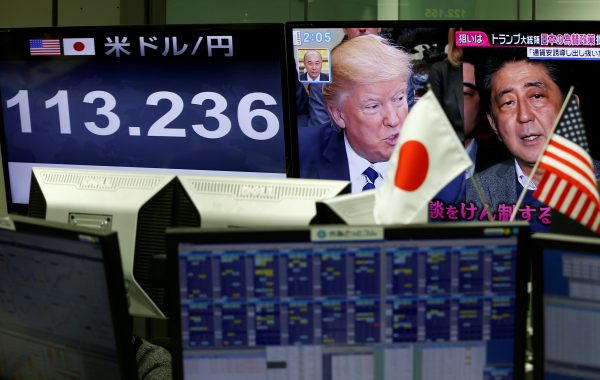For the Abe administration, this represents an unwelcome return to Japan’s ‘America problem’ of the 1980s and 1990s. In those decades, successive Japanese governments faced a litany of requests, demands, suggestions and even instructions as to how they should run their economy for the benefit of the United States and how it should stop ‘free riding’ and ‘spend more’ on defence to assume a fairer share of its own security burden.
Not surprisingly, the Abe government is turning to the old playbook for dealing with new ‘foreign pressure’ (gaiatsu) from the United States on the economic and trade fronts. Japan’s responses were honed to a fine art and still seem useful and relevant. They are particularly needed when Japan has once more to demonstrate its value and importance to the United States and perhaps even rebuild the bilateral relationship from the ground up.
One classic response was for Japan to use ‘package diplomacy’, often incorporating ‘gift diplomacy’ (omiyage gaikō). Japan would announce a ‘package’ of planned actions, offerings or concessions to the United States in order to take the heat out of pressing US–Japan bilateral issues.
Japanese prime ministers and ministers often went to the United States for summit and other high-level visits bearing a package of such offerings. ‘Gift diplomacy’ could also be twinned with the tactic of ‘substitution compensation’, where Japan would not agree with a particular US demand but would offer some other kind of concession instead.
These are just the sort of tactics that have informed the ‘package’ of economic cooperation ‘gifts’ that Abe will take to the United States this week. These include the provision of direct financial, engineering and technical input into Trump’s proposed infrastructure development program as well as other proposals for cooperation in cutting-edge technologies such as commercial aircraft, robots and artificial intelligence.
Should the United States accept these proposals, Japan will be investing in areas where it still has some comparative advantage and substituting these ‘concessions’ for those demanded by Trump, such as alleged currency manipulation and the ‘imbalance’ in auto trades between the two countries. Abe cannot concede on the former because a weaker yen is a by-product of his government’s monetary easing policy, which is one of the three arrows of his ‘growth strategy’. The barriers to US car sales in Japan have a lot more to do with consumer preferences, and the ‘Big Three’ American carmakers’ failure to promote small car sales in Japan, than trade barriers such as tariffs. The Japanese government cannot force its citizens to buy cars made in the US.
The next question the Abe administration faces is what it can do to deal with Trump’s accusation that it does not bear a big enough share of the cost burden of US bases in Japan. With his remarks about this ‘imbalance’, Trump has effectively put a much higher price on the US security guarantee to Japan. Japan must now ask itself what more it has to do to ‘buy’ US security protection in the face of an increasingly hostile environment in East Asia. Japan’s particular sensitivity is in maintaining the US commitment to defending the Senkaku Islands under the terms of the US–Japan Security Treaty. Although US Secretary of Defense James Mattis offered reassurance on this score during his recent visit to Tokyo, how much more Japan will be asked to do in terms of its contribution to the alliance remains to be seen .
Perhaps the most important problem for Abe and other long-standing US friends and allies will be where to draw the line between capitulation and standing their ground as well as between defending national interests and serving US interests as defined by Trump. In the short term, Japan is hoping to deal with this issue by broadening the number of participants in high-level dialogues between the two governments, in the hope of drawing in other members of the Trump team into the decision-making process.
Aurelia George Mulgan is a Professor at the University of New South Wales, Canberra.

